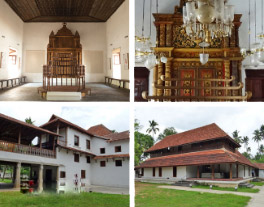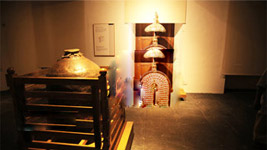The Perumals
Sthanu Ravi was the first Perumal to be installed at Thirunavai in 887 CE. He and many of his successors were Cheras. His reign cannot have been earlier than the last quarter of the 9th century.
Bhaskara Ravi Varman I who is said to have issued a Jewish copper plate from Musiri to Joseph Rabban the Jew, was not a resident of that place. It is clearly stated in the document that he was only camping there when he issued the document.
Mushikas and Venadu kings were subservient to Karnataka and Pandya rulers respectively. The central region of Malainadu, viz., Kerala, continued as a province of the Chera kingdom. Hence Malainadu got the name Kerala and the institution of Perumal came to be known as Kerala Perumal.
As Eastern Cheras were vassals of Karnataka, they were known as Kongu Cheras and that part of the Chera country came to be known as Kongunadu. This region which was the hinterland of Musiri, and Thondi helped in the growth of the two port cities. With the loss of that territory, the primacy of Musiri was lost and Thondi faded into oblivion.
The Palace of the Perumals
Cheraman Parambu is an important site included in the Muziris Heritage Project. During the time when the Cheras ruled over Kerala, they set up their palace at Cheraman Parambu in their capital of Kodungallur. Today it wears a deserted look, a far cry from a bustling centre it must have been in the ancient times. It is hard to believe that this nondescript stretch of land that has suffered years of neglect was once a busy hub, thrumming with all kinds of human activity.
A reference to this palace can be found in a work titled Laghu Bhaskareeya Vyakhya written at around 870 CE. The work features a conversation between its author Sankara Narayana the poet and the Perumal of that time named Sthanu Ravi. The splendour of the place – reflected in the capital city, its streets, palatial buildings, royal residences and so on - finds special mention in it. The prosperous and majestic area was also known as Gotramalleswaram during that time. To the north of the palace was a temple known as Balakreedeshwaram, dedicated to Lord Ganapati. And close to it stood an observatory and certain yantras, which were used to tell the time, and view the stars.
A title deed inscribed in copper plates (known as Veeraraghava pattayam) created in the 13th century indicates that the capital of the Chera Perumals was known by the name Perum kovilakam [the big palace]. But by the time Kokasandesham, a 14th century work of Tamil literature, was composed, the scenario had changed beyond recognition. The poem describes Kodungallur as a place that once rivalled the heavens in prosperity. By then, the fortune of the Perumals was on the decline, and the star of Cochin royal family was on the ascendant.
Today, excavated remnants of gigantic walls, iron and copper nails, hooks and pillars bearing sculpted figures are all that exist to remind us of a period of glory and greatness that Kodungallur once enjoyed. Those palaces, palatial buildings, store houses, shops and markets have been washed away by the flood waters of time. What was once the capital city of the Perumals has dwindled into a waste land, overrun by weeds. It is only the signboard put up by the archaeological department of the state that gives the passing visitor a glimpse into the past – the story of a city that it was once a dynamic administrative centre during a glittering phase of the history of Kerala.

